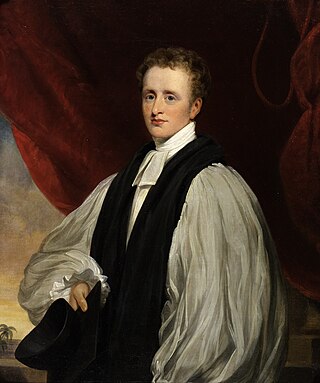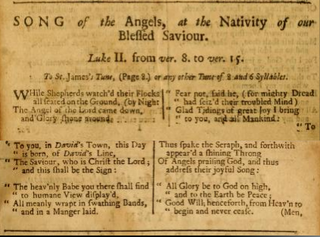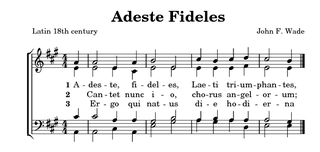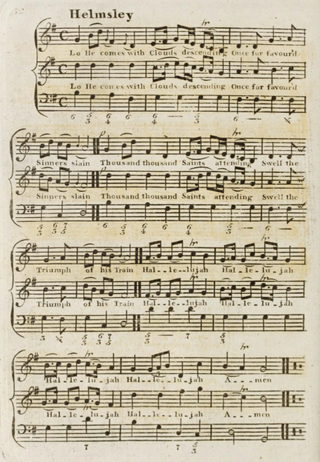
A hymn is a type of song, and partially synonymous with devotional song, specifically written for the purpose of adoration or prayer, and typically addressed to a deity or deities, or to a prominent figure or personification. The word hymn derives from Greek ὕμνος (hymnos), which means "a song of praise". A writer of hymns is known as a hymnist. The singing or composition of hymns is called hymnody. Collections of hymns are known as hymnals or hymn books. Hymns may or may not include instrumental accompaniment.

A hymnal or hymnary is a collection of hymns, usually in the form of a book, called a hymnbook. They are used in congregational singing. A hymnal may contain only hymn texts ; written melodies are extra, and more recently harmony parts have also been provided.

John Byrom or John Byrom of Kersal or John Byrom of Manchester FRS was an English poet, the inventor of a revolutionary system of shorthand and later a significant landowner. He is most remembered as the writer of the lyrics of Anglican hymn "Christians, awake, salute the happy morn", which was supposedly a Christmas gift for his daughter.
"Joy to the World" is an English Christmas carol. It was written in 1719 by the English minister and hymnwriter Isaac Watts, and its lyrics are a Christian reinterpretation of Psalm 98. The carol is usually sung to an 1848 arrangement by the American composer Lowell Mason.
"Old 100th" or "Old Hundredth" is a hymn tune in long metre, from the second edition of the Genevan Psalter. It is one of the best known melodies in many occidental Christian musical traditions. The tune is usually attributed to the French composer Louis Bourgeois.

"O for a Thousand Tongues to Sing" is a Christian hymn written by Charles Wesley. The hymn was placed first in John Wesley's A Collection of Hymns for the People Called Methodists published in 1780. It was the first hymn in every (Wesleyan) Methodist hymnal from that time until the publication of Hymns and Psalms in 1983.

Once in Royal David's City is a Christmas carol originally written as a poem by Cecil Frances Alexander. The carol was first published in 1848 in her hymnbook Hymns for Little Children. A year later, the English organist Henry Gauntlett discovered the poem and set it to music.
"For the Beauty of the Earth" is a Christian hymn by Folliott S. Pierpoint (1835-1917).

"Holy, Holy, Holy! Lord God Almighty!" is a Christian hymn written by the Anglican bishop Reginald Heber (1783–1826).

"While shepherds watched their flocks" is a traditional Christmas carol describing the Annunciation to the Shepherds, with words attributed to Irish hymnist, lyricist and England's Poet Laureate Nahum Tate. It is listed as number 16898 in the Roud Folk Song Index.

A hymn tune is the melody of a musical composition to which a hymn text is sung. Musically speaking, a hymn is generally understood to have four-part harmony, a fast harmonic rhythm, with or without refrain or chorus.

"Wachet auf, ruft uns die Stimme" is a Lutheran hymn written in German by Philipp Nicolai, first published in 1599 together with "Wie schön leuchtet der Morgenstern". It appears in German hymnals and in several English hymnals in translations such as "Wake, Awake, for Night Is Flying", "Wake, O wake! with tidings thrilling", and "Up! Awake! From Highest Steeple". Johann Sebastian Bach based a chorale cantata on the hymn, Wachet auf, ruft uns die Stimme, BWV 140, one of its many musical settings.
"See, amid the Winter's Snow", also known as "The Hymn for Christmas", is an English Christmas carol, written by Edward Caswall and first published in 1858. In 1871 Sir John Goss composed a hymn tune for it, "Humility", and as "Hymn for Christmas Day", it was included in Christmas Carols New And Old, the anthology edited by Henry Ramsden Bramley and John Stainer.
Long metre or long measure, abbreviated as L.M. or LM, is a poetic metre consisting of four line stanzas, or quatrains, in iambic tetrameter with alternate rhyme pattern ABAB. The term is also used in the closely related area of hymn metres. When the poem is used as a sung hymn, the metre of the text is denoted by the syllable count of each line; for long metre, the count is denoted by 8.8.8.8, 88.88, or 88 88, depending on style.

"Praise to the Lord, the Almighty" is a Christian hymn based on Joachim Neander's German-language hymn "Lobe den Herren, den mächtigen König der Ehren", published in 1680. John Julian in his A Dictionary of Hymnology calls the German original "a magnificent hymn of praise to God, perhaps the finest creation of its author, and of the first rank in its class."
John Wainwright (1723–1768) was an English church organist and composer. He was appointed organist and singer at the Manchester Collegiate Church on 12 May 1767, a year after the publication of his A Collection of Psalm Tunes, Anthems, Hymns and Chants, which included the Christmas hymn "Christians Awake, Salute the Happy Morn".

"Ride On, Ride On in Majesty!", also titled "Ride On! Ride On in Majesty", is a Christian hymn written by Henry Hart Milman in 1820. It is a Palm Sunday hymn and refers to Matthew 21:1–17 and Jesus' triumphal entry into Jerusalem.

"Praise, my soul, the King of heaven" is a Christian hymn. Its text, which draws from Psalm 103, was written by Anglican divine Henry Francis Lyte. First published in 1834, it endures in modern hymnals to a setting written by John Goss in 1868, and remains one of the most popular hymns in English-speaking denominations.

"Lo! He comes with clouds descending" is a Christian hymn by Charles Wesley (1707–1788), based on an earlier hymn, "Lo! He cometh, countless Trumpets" by John Cennick (1718–1755). Most commonly sung at Advent, the hymn derives its theological content from the Book of Revelation relating imagery of the Day of Judgment. Considered one of the "Great Four Anglican Hymns" in the 19th century, it is most commonly sung to the tune Helmsley, first published in 1763.
"Nun jauchzt dem Herren, alle Welt" is a German Christian hymn, a paraphrase of Psalm 100. The text was written by David Denicke, based on a metered paraphrase of the psalm from the Becker Psalter, and published in his 1646 hymnal. The song appears in modern German-language hymnals, such as the Protestant Evangelisches Gesangbuch and the Catholic Gotteslob. With a joyful melody derived from a 14th-century model, it is one of the most popular psalm songs in German.















